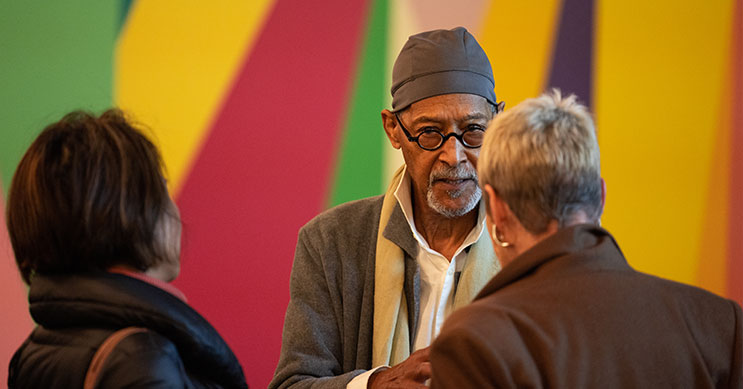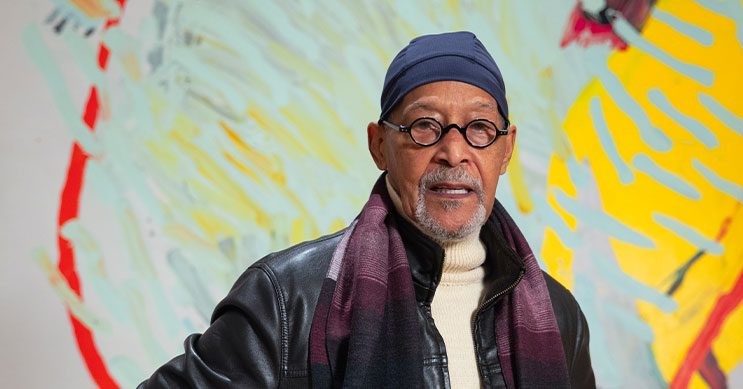How Iowa Helped Oliver Lee Jackson Find His Artistic Calling
Jackson Pollock’s Mural had been at the University of Iowa barely a decade when Oliver Lee Jackson arrived on campus.
“It moved me, but I didn’t necessarily like it,” says Jackson (63MFA), a graduate of the UI School of Art and Art History. “I thought I knew what painting was, and I argued that you can't paint like that. But there was the painting. ... It helped open my eyes and way of thinking.”
Sixty years later, Jackson’s Painting (4.78-I) and Painting (4.78-II) hang along with Mural in the UI Stanley Museum of Art’s inaugural exhibition. In fact, the Iowa alumnus’ paintings, sculptures, and prints can be found in the collections of museums across the country, including the National Gallery of Art in Washington, D.C., the Metropolitan Museum of Art in New York, Art Institute of Chicago, and San Francisco Museum of Modern Art.
Born in St. Louis in 1935, Jackson received his BFA from Illinois Wesleyan University in 1958. When Jackson enrolled at Iowa in the early 1960s after serving in the U.S. Army, he says he was welcomed by faculty including Byron Burford (42BFA, 47MFA) and James Lechay.
“It’s a calling, and I answer it the best I can. It has nothing to do with making a masterpiece or being successful. It’s demanded of me, and I yield to it.” —Oliver Lee Jackson (63MFA)
ON HIS APPROACH TO ART
“They gave me a job teaching figure drawing with Lechay so I could support myself and my family,” Jackson says. “They understood my circumstances and made it possible that I could make it here. I had to be very clear in my objectives. I couldn’t just be hanging around school to hang around school. I graduated in two years. It was a three-year program, but they understood I couldn’t afford that.”
Jackson says he appreciated that Iowa didn’t separate the art historians from the makers. In the 1920s, studio art and art history were combined to form the School of Art and Art History. This innovative model became known as the “Iowa Idea” and would go on to become the standard for arts programs across the country.
He also notes that art students often interacted with graduate students in other disciplines, especially writing.
“It was exciting to meet all these serious people, some of whom had already published,” Jackson says. “There was so much going on at that time, such as the Van Allen radiation belts and what they were doing in physics. It was an incredible mix of graduate-level people who were intensely involved in their disciplines. The exchanges were very intense and knowledgeable. It was really exciting.”
 PHOTO: JASON SMITH
Oliver Lee Jackson speaks to attendees at a talk at the University of Iowa Stanley Museum of Art this past February.
PHOTO: JASON SMITH
Oliver Lee Jackson speaks to attendees at a talk at the University of Iowa Stanley Museum of Art this past February.
During a trip back to campus in February 2023 for a lecture and residency, Jackson recalled his time in Iowa City as important for gaining a better understanding of his use of materials and assessing his intentions during the making process.
But, he says, the work of finding his voice and confidence in his work continued well after he left.
“I had the skills; I had an understanding,” Jackson says. “But my vision—it took awhile for me to understand what I was doing and not copying anyone, and to become confident about each mark I was making and that I didn’t need anybody over my shoulder because I was my own best and worst critic.”
After graduating with an MFA, Jackson returned to St. Louis. There, he worked extensively with community-based arts groups, including the People’s Art Center and Program Uhuru, which he started in order to offer low-income youths a constructive means of developing dialogue through arts programs. Jackson also became involved with the Black Artists Group, which included musicians, theater artists, dancers, and visual artists devoted to raising Black consciousness, battling social injustice, and exploring the far reaches of experimental performance.
Over the decades, Jackson has created a masterful, complex body of work—one that led Harry Cooper, senior curator and head of the department of modern art at the National Gallery of Art, to remark upon the opening of a solo exhibition by Jackson, “If we were in Japan, Oliver Lee Jackson would be what they call a living national treasure.”
“There was so much going on at that time, such as the Van Allen radiation belts and what they were doing in physics. It was an incredible mix of graduate-level people who were intensely involved in their disciplines. The exchanges were very intense and knowledgeable. It was really exciting.” —Oliver Lee Jackson (63MFA)
ON HIS TIME AT IOWA
Adds Lauren Lessing, director of the UI Stanley Museum of Art, “In painting after painting and in sculptures, prints, and drawings, too, Jackson has broken new ground: combining figuration and abstraction in innovative ways, deploying color and space like no painter since Joan Mitchell, unleashing stunning, virtuoso improvisations inspired by jazz, and exulting in the joy of making.”
Lessing says Iowa’s museum made acquiring work by important alumni a central goal—and a diptych of Jackson’s now offers visitors a master class in composition.
“Like anyone who follows contemporary art, I’d known of Mr. Jackson’s work for years. He’s a beautiful, exciting, innovative painter whose deft handling of his materials is just so compelling,” Lessing says. “I’m proud to work at the university where he began his career.”
Jackson, who now lives and works in Oakland, California, says making art is very personal to him.
“It’s a calling, and I answer it the best I can,” Jackson says. “It has nothing to do with making a masterpiece or being successful. It’s demanded of me, and I yield to it.”
Jackson to Receive Honorary Degree
The University of Iowa will award Oliver Lee Jackson (63MFA) an Honorary Doctor of Humane Letters degree during its May 2023 commencement ceremonies.
The painter, sculptor, and printmaker says he is flattered by the honor. But he is even more moved by the inclusion of two of his works—Painting (4.78-I) and Painting (4.78-II)—in the Stanley Museum of Art’s inaugural exhibition upon reopening in 2022.
“I think this museum is quite wonderful,” Jackson says. “That the objects I made are in company with these wonderful objects, I really respond to that personally.”
 PHOTO: JOHN EMIGH
Oliver Lee Jackson is pictured in front of one of his two paintings on display inside the University of Iowa Stanley Museum of Art this past February.
PHOTO: JOHN EMIGH
Oliver Lee Jackson is pictured in front of one of his two paintings on display inside the University of Iowa Stanley Museum of Art this past February.
Work Revisited
Oliver Lee Jackson completed Painting (4.78-I) and Painting (4.78-II), which now hang in the Stanley Museum of Art, in 1978. During a visit to the museum in February 2023, Jackson reflected on seeing his paintings again after many years.
“I look at them with very clear eyes because I no longer have the closeness and time invested in evaluating them that you have when you make something,” Jackson says. “You may not be seeing clearly because you have just finished it and like what you see. But that doesn’t mean that 10 years from now it will stand up to cold scrutiny.
“When I came in here and looked at them, I thought, ‘Yeah, they’re OK.’ What I mean is the oneness of them. Even though they’re similar in application and different in field, this one does not feel like that one. They each make a different demand and they seem sure of themselves. So, that’s cool. They pass my muster. It was wonderful for them to engage me in this way.”
Jackson on Art Education
Over the years, Jackson has taught and lectured in art, philosophy, and Pan-African humanities, as well as served as an artist-in-residence or visiting artist at numerous institutions.
However, Jackson says what he does is train, not teach.
“They make themselves artists; I don’t,” Jackson says. “I don’t think you should make any student under you a follower of what you do, but instead bring them to the deepest understanding, without romanticism, of the intimacy that you need to feel very, very comfortable with your materials—whether that is paint, bronze, steel. I want them to be able to assess their intention and be critical in a powerful way of themselves and not stumble over not understanding materials or techniques.”
